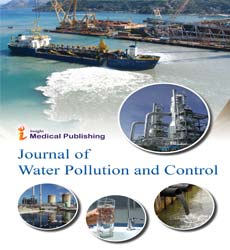River Water Pollution Control Based on Environmental Legislation and its Implementation aganist Pollution Deli River in Medan Connected with Integrated River Management System
Marium D’souza*
Managing Editor, Journal of Water Pollution and Control, London, UK
- *Corresponding Author:
- Marium D’souza
Managing Editor
Journal of Water Pollution and Control
London, UK
E-mail: riumza345@hotmail.com
Received Date: May 08, 2021; Accepted Date: May 22, 2021; Published Date: May 29, 2021
Citation: D’souza M (2021) River Water Pollution Control Based on Environmental Legislation and its Implementation aganist Pollution Deli River in Medan Connected with Integrated River Management System. J Water Pollut Control. Vol. 3 No. 3:17.
Abstract
Water pollution control is an inherent aspect of river management, and the attempt to address the problem is inextricably linked to river management systems' integrated approach. River water pollution control must be done in a multi-sectorial, upstream-downstream, quantity-quality, and long-term, environmentally sound (ecosystem conservation) manner, with the river basin (hydrological Territorial unit) serving as a management unit. The Deli River in Medan has a high pollution rate, which can be decreased and addressed by implementing a river management pattern in one unit of river basin, while adhering to the legal norms set forth in the current environmental legislation.
Introduction
Water is a natural resource that is a gift from the almighty God and is required by humans at all times. It is a crucial aspect of human fundamental necessities. All aspects of human life, from food production to industrial expansion, necessitate an adequate supply of water of the appropriate quality. As a result, water is required not just as a living necessity but also as a commercial product. Water ecosystems, being part of natural resources, are not immune to negative aspects. Human use has an impact on the physical and chemical status of the environment. As a result, the aquatic environment as a habitat for many forms of body water changed dramatically. Although water is a strategic resource, it is insufficient if it is only regarded as a resource. Water has a deeper meaning than that. Water is a source of basic human requirements because it is required in practically every aspect of existence. Water, on the other hand, has a tendency to be squandered when it is plentiful and sought after when it is scarce. Because water is a public good that cannot be held by anybody, cannot be alienated, and has a weak Property Right, it is customary for water to be considered as a shared resource, i.e. jointly managed resources, rather than for sale or trading for profit.
Human beings are part of the environment, or human elements, according to environmental knowledge, and are subsystems of the environment in which each component in the living environment interacts with one another to generate regularity. Because there is a flow of material and energy controlled by the flow of information between environmental elements in an ecosystem, regularity can develop. As a result in an ecosystem all elements of the environment work together to create balance, stability and environmental productivity by mutually affecting one another. In environmental studies, exploitation of natural resources based solely on economic considerations without regard for ecological concerns has resulted in the critical state of diverse natural resources. The river, as humanity's basic source of life, plays a role in providing water supplies and modes of transportation to increase mobility and communication.
Result and Discussion
Water resources include water, water resources, and water resources that are contained inside it. Groundwater resources and surface water resources are the two types of water resources. Groundwater resources (natural water resources) are a source of clean water found in the soil and rocks. Surface water resources are the bodies of water on the Earth's surface, such as rivers, lakes, and oceans. Water is a resource that can be classed as renewable or non-renewable, depending on its source and use.
Open Access Journals
- Aquaculture & Veterinary Science
- Chemistry & Chemical Sciences
- Clinical Sciences
- Engineering
- General Science
- Genetics & Molecular Biology
- Health Care & Nursing
- Immunology & Microbiology
- Materials Science
- Mathematics & Physics
- Medical Sciences
- Neurology & Psychiatry
- Oncology & Cancer Science
- Pharmaceutical Sciences
